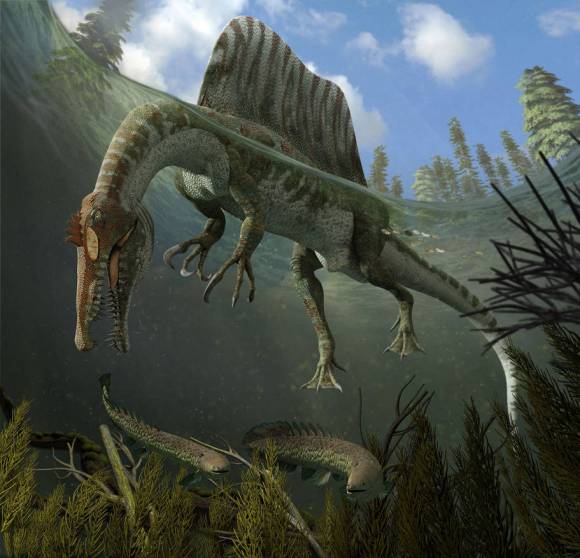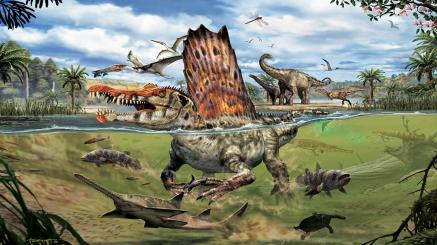The Sahara Desert encompasses a desolate, unforgiving landscape. With a year-round average temperature of 30° Celsius, it is easy to see why the population density of the Sahara is amongst the lowest in the world; just 2.5 million people live within the 3.5 million kilometers that make up the vast sand dunes of the region. On the surface, the Sahara appears to be a massive sandbox, a region that does not resemble a habitat which could accommodate life. However, the Sahara is far from desolate; in fact, it is teeming with life. Various species call it their home, including everything from frogs to crocodiles. While over 260 species of reptiles, birds and mammals call the Sahara home today, the Sahara possessed a much different landscape in the past.

When the supercontinent Pangea split apart approximately 200 million years ago, it was divided into two separate land masses; Laurasia (modern day North America, Europe and Asia) and Gondwana (now known as Africa, South America, Australia, Antarctica, India and Madagascar). During that period, northern Africa was covered by a shallow sea, that paleontologists know today the Tethys Sea. This seaway opened into a series of vast rivers and lagoons, similar to the Congo River today. These water systems proved to be the perfect habitat for a variety of giant carnivorous dinosaurs, crocodiles and fish. One specific species has captured the imagination of paleontologists unlike any other; a carnivore that was larger than T-Rex, possessed a 2 meter tall sail on its back, but ate a diet that largely consisted of fish. While a lot of research has been done on this animal since the start of the 21st century, its story began 100 years ago in the Egyptian dessert.
The year is 1911. In years previous, numerous mammal fossils from approximately 35 million years ago, including the early whales Basilosaurus and Dorudon and the aquatic elephant Moeritherium, had turned up in the El Fayoum region of the Egyptian dessert. Upon hearing about these discoveries, German fossil hunter Ernst Stromer saw the sands of Egypt as the perfect place to find fossils that could prove his hypothesis that all mammals originated from Africa. Instead of finding early mammals though, Stromer found a variety of giant dinosaurs. While his endgame was to ship the fossils back to Munich, Germany, he encountered difficulty, as it was impossible to ship them due to World War 1. Eventually in 1922, the fossils arrived in Munich, but many of them were damaged or outright shattered. In the end, Stromer had discovered 3 species of large, carnivorous dinosaurs: Spinosaurus, Carcharodontosaurus, and Bahariasaurus, two of which (Spinosaurus and Carcharodontosaurus) being larger than Tyrannosaurus.
Stromer and his team also discovered the Sauropod Aegyptosaurus, which is known from very little fossil material. Stromer was particularly entranced with the fossils of Spinosaurus. After its discovery, Stromer spent the better part of the next 20 years describing the fossils he had discovered; the previously mentioned 2-meter long spines, along with a few vertebra, a lower jaw bone and an assortment of teeth from  Spinosaurus. Stromer’s discovery seemed to be a staple of paleontology for years to come; but politics took over. In 1933, Adolf Hitler and the Nazi party rose to power in Germany. Once the Second World War had begun, Stromer feared that allied bombing raids would destroy the fossils he had discovered. Stromer pleaded for the fossils of Spinosaurus and his other dinosaurs to be transported away from Munich’s Alte Akademie, but was ignored by those in charge of the museum. Stromer’s fears came true on the 25th of April, 1944, when an allied bombing led to the destruction of all the fossils Stromer had collected. After the war, fossil hunting in Africa became very limited, and it seemed as though Spinosaurus would be forgotten in the past, a lost relic destroyed by the conquests of man, only to be remembered by a few photos taken before they were destroyed.
Spinosaurus. Stromer’s discovery seemed to be a staple of paleontology for years to come; but politics took over. In 1933, Adolf Hitler and the Nazi party rose to power in Germany. Once the Second World War had begun, Stromer feared that allied bombing raids would destroy the fossils he had discovered. Stromer pleaded for the fossils of Spinosaurus and his other dinosaurs to be transported away from Munich’s Alte Akademie, but was ignored by those in charge of the museum. Stromer’s fears came true on the 25th of April, 1944, when an allied bombing led to the destruction of all the fossils Stromer had collected. After the war, fossil hunting in Africa became very limited, and it seemed as though Spinosaurus would be forgotten in the past, a lost relic destroyed by the conquests of man, only to be remembered by a few photos taken before they were destroyed.
For the next 75 years, our understanding of Spinosaurus stayed the same. Starting in 1996, numerous Spinosaurus fossils were discovered, but all of them were very limited in the amount unearthed. While 5 separate specimens were discovered, all of them consisted of the skull and teeth of the animal. Despite the lack of materials, the skulls gave a clear picture of the kind of animal Spinosaurus was. The shape of the skull was very similar to that of a crocodile, which led paleontologists to believe that Spinosaurus could be the first aquatic dinosaur. The shape was far from the only evidence that led to this assumption; chemical analysis of the skull and teeth of Spinosaurus were compared to those of turtles and crocodiles, as well as other carnivorous dinosaurs, mainly Carcharodontosaurus. The chemicals in the teeth were very similar to those of crocodilians, leading paleontologists to believe they lived at least part of their lives in water. The shape of their teeth is far from those associated with any other carnivorous dinosaurs; they are blunt and conical, which would be ideal for catching large species of fish. The nostrils of Spinosaurus are positioned towards the back of their skull, which would have served to helped the animal to breathe as it hunted for fish. Located at the front of Spinosaurus’ snout is a series of large holes; these holes, like those of crocodiles and alligators, would have been able to detect movement in the water when the animal was alive. Beyond all of its adaptations, there is even more evidence for Spinosaurus to be considered a pescetarian. Fish fossils have been discovered within the stomach of Baryonyx, a close relative of Spinosaurus. Even more conclusive proof is that a barb (tooth) of an Onchopristis, a 12 meter long sawfish, were embedded within the jaw of a Spinosaurus. While the jaws managed to show us what type of animal Spinosaurus was, we still had no idea what it looked like.
 In 2013, fossil hunter Nazir Ibrahim found the most complete Spinosaurus fossil to date in Morocco. After excavating the skeleton, Ibrahim took the bones from The Moroccan Spinosaur, as well as 2 other specimens from Milan and Casablanca, to Chicago to get the aid of Paleontologist Paul Sereno. They compared these fossils, as well as the photos of Stromer’s fossils, to create a picture of what Spinosaurus would have looked like. At 15 meters long, Spinosaurus is the largest carnivorous that has been discovered, but it is unlikely that it would have engaged in combat with other large carnivores in its habitats. The skeleton of Spinosaurus was a complete anomaly to other carnivorous dinosaurs. Its hind legs were rather short; when it was alive, it is more than likely that Spinosaurus would have walked on all 4 legs. It had dense bones and a flexible tail, both adaptations that would have assisted it when swimming. While the sail of Spinosaurus does not have a clear function, it is likely it could have used it for regulating heat, or possibly to display to other carnivores that it was a very large and imposing animal. Despite sharing its environment with other massive carnivores, such as Carcharodontosaurus, Spinosaurus would have been able to avoid competing for food, as giant sawfish, coelacanths and lungfish occupied the waters that Spinosaurus called home, giving it plenty of food to dine on.
In 2013, fossil hunter Nazir Ibrahim found the most complete Spinosaurus fossil to date in Morocco. After excavating the skeleton, Ibrahim took the bones from The Moroccan Spinosaur, as well as 2 other specimens from Milan and Casablanca, to Chicago to get the aid of Paleontologist Paul Sereno. They compared these fossils, as well as the photos of Stromer’s fossils, to create a picture of what Spinosaurus would have looked like. At 15 meters long, Spinosaurus is the largest carnivorous that has been discovered, but it is unlikely that it would have engaged in combat with other large carnivores in its habitats. The skeleton of Spinosaurus was a complete anomaly to other carnivorous dinosaurs. Its hind legs were rather short; when it was alive, it is more than likely that Spinosaurus would have walked on all 4 legs. It had dense bones and a flexible tail, both adaptations that would have assisted it when swimming. While the sail of Spinosaurus does not have a clear function, it is likely it could have used it for regulating heat, or possibly to display to other carnivores that it was a very large and imposing animal. Despite sharing its environment with other massive carnivores, such as Carcharodontosaurus, Spinosaurus would have been able to avoid competing for food, as giant sawfish, coelacanths and lungfish occupied the waters that Spinosaurus called home, giving it plenty of food to dine on.
Spinosaurus was a specialist; an example of how evolution can allow certain animals to thrive together despite their differences. However, it is likely that Spinosaurus’ specialization caused it to go extinct; the area in which it lived went through annual dry periods, which could have lasted for months. During these droughts, Spinosaurus’ usual food supply would temporarily disappear, and without the mobility to hunt on land, the Spinosaurs would have starved, and died out. With the extinction of Spinosaurus, one thing is clear; the world will never see something so odd yet magnificent again.

One reply on “The 100 Year Old Dinosaur Mystery”
[…] on Spinosaurus focus on its bizarre anatomy and behaviours, including how it may have been the first aquatic dinosaur known to science. Undoubtedly, the notion that the largest known carnivorous dinosaur lived far […]
LikeLike